Rituals in Transfigured Space:
Interview with Stephen Broomer
By Clint Enns
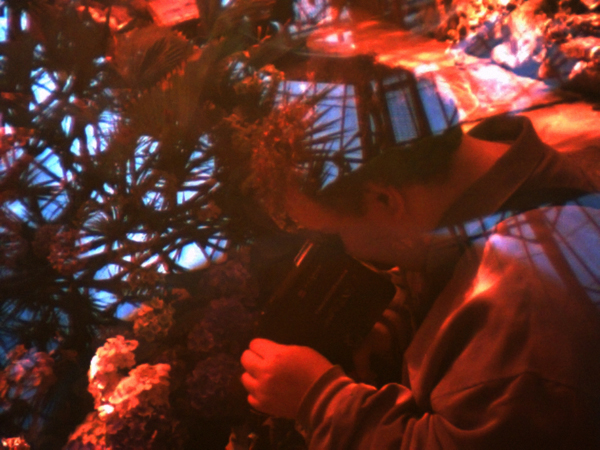
Image: Stephen Broomer shooting Super 8 film. Photo by Clint Enns.
Stephen Broomer is a Toronto-based filmmaker whose work freely transposes between Super 8, 16mm, and video. However, despite this hybrid methodology, Broomer typically finishes and exhibits his work on 16mm. Pepper’s Ghost (2013), his most accomplished piece to date, is an exception; made with a digital SLR, it features complex in-camera superimpositions. It premieres as part of the Toronto International Film Festival’s “Wavelengths” series on September 7, 2013.
In addition to his prolific filmmaking, Broomer has restored John Hofsess’ neglected underground hit, Palace of Pleasure (1966/67) and many other experimental films produced by McMaster University’s Film Board in the 1960s and 70s. His book exploring the history of the McMaster Film Board is coming soon. Broomer is also a member of Toronto’s Loop Collective, an organization of film and video artists dedicated to producing and exhibiting experimental artworks.
This interview began over many cups of coffee and during days spent hanging out and shooting still and moving images. The final version was conducted by e-mail.
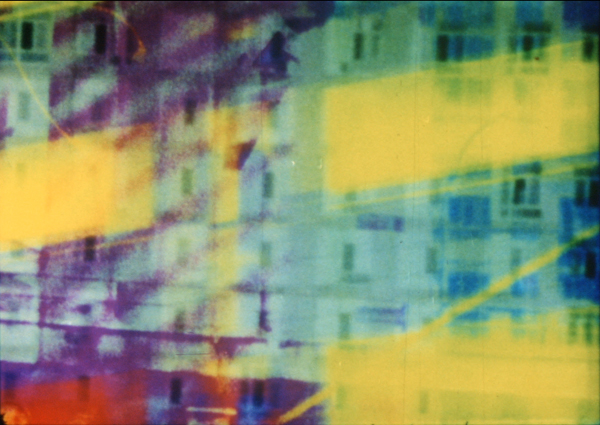
Image: Queen's Quay (Stephen Broomer, 2012). Courtesy of the artist.
Clint Enns: How did you begin making experimental cinema?
Stephen Broomer: I read my father’s copy of Sheldon Renan’s Introduction to the American Underground Film when I was 14. At the time, I didn’t have access to most of those films. The first thing I did when I began studying at York University was watch their print of Wavelength (1967). I got a Super 8 camera to do a class assignment – we were supposed to film an environment, something general like that – and I shot a film that later became Manor Road (2010). It was very different in its original form – it was just a series of long shots of trains going under a bridge at Manor Road and Yonge Street, from late afternoon to night, spaced out with time lapse between each train. I made some other films that summer, and I started using those films as the basis for new work when I resumed making films eight years later, in 2010. I came back to experimental film around 2006, when I started doing a Master’s degree in film history and working in film preservation. I had a lot of false starts, but my work as a filmmaker really began in 2010, when I finished Manor Road in its present form. I’m still developing work from old reels of Super 8.
CE: There seems to be aesthetic similarities between your work and some of the other members of the Loop Collective, in particular Dan Browne and Izabella Pruska-Oldenhof. I am thinking about your use of colour and superimposition, your interest in materiality, and your embrace of hybrid forms.
SB: Well, we see each other’s films, and we often screen together, so I’m sure their work has influenced me. Over time, I am beginning to see more differences emerge in our work, but we’re all starting from a common history. I would not be making such films today if not for Izabella’s encouragement.
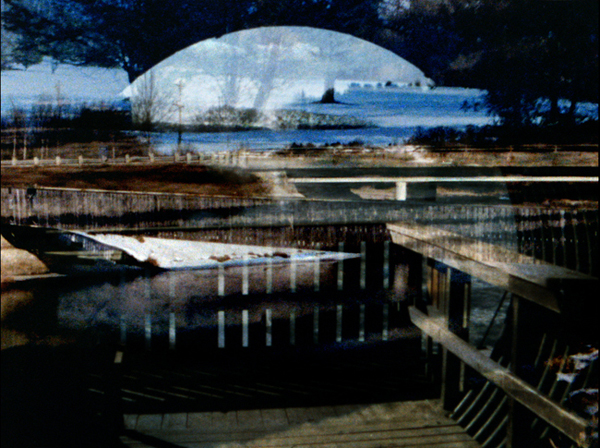
Image: Brébeuf (Stephen Broomer, 2012). Courtesy of the artist.
CE: You and Dan also had a show together at Toronto’s I·M·A Gallery, Superimposition, which featured a series of enlarged photographic stills from your films Brébeuf (2012) and Christ Church – Saint James (2011). Why did you decide to exhibit film stills? What was your selection process?
SB: I started exhibiting film stills as photographic prints as a way of translating my work into something that could be sold or gifted to interested parties. My films are at times discontinuous – individual frames pass faster than one can perceive them. Dan’s piece, memento mori (2012), deals in this discontinuity as well: rapidly passing images construct brief episodes, they transition from one setting to another in a matter of seconds, and register only as light, a time of day, a face, a landscape receding. To counter that, I pulled out images from my film Brébeuf and turned them into large photographic prints, all featuring the same circular motif. My selection process was limited to images featuring this circle, which is the mouth of a tunnel at Sainte-Marie-au-pays-des-Hurons. I chose images of diverse color values, two heavily saturated, one pale, one almost black. These images form the series Midland, which is the name of the Ontario city where they were shot. In the series, landscapes are half-formed or half-present: the mouth of a tunnel is superimposed with between two and six other images of incompatible landscapes – water, snow, road. A fifth print was included in the exhibition, taken from Christ Church – Saint James. The print was titled Toussaint, named for Stephen Toussaint, who is accused of the arson that destroyed the church. It’s from the first sequence of the film – we see the remaining walls of the church, peaking up over a hill that hides a deep pit of charred tiles, graffiti and detritus. None of the pit is seen; in Toussaint, all you see is the land and an ambiguous fragment of the building, a window or a door.
CE: Christ Church – St. James is the site of a church lost to arson and linked to a bizarre, unsolved double homicide/homicide-suicide. In the film you document its charred and graffiti-ridden ruins. Similarly, in Brébeuf, as previously mentioned,you document sites in Midland, a region that was central in the missionary and ethnographic work of Jean de Brébeuf and Gabriel Lalemant, Jesuit missionaries who were brutally tortured and murdered by the Iroquois. What initially drew you to these locations: their history, their mythology, or their aesthetic qualities? Are your films intended as archival documents?
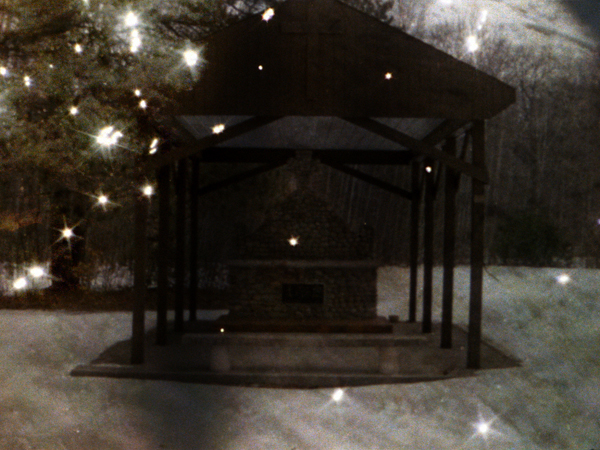
Image: Brébeuf (Stephen Broomer, 2012). Courtesy of the artist.
SB: In these places, history and legend, fact and mythology, mix and become clouded over. It would be impossible to separate fact from mythology in Brébeuf and Lalemant’s story. The same is true about the night where Toussaint purportedly murdered his coworker (whose body was found on a slab in the medical science lab at the University of Toronto), set his family church on fire, and fled. I was drawn to Christ Church by that story, not just the horror and drama of it, but the mythology of it, the hysteria surrounding it, and above all, its ambiguity. Toussaint was an unlikely suspect, a man with no history of violence; however, some were certain of his guilt. There’s memory and rebirth in that pit, a cleansing fire, but a fire that devastated a community. I was treading on a memorial, venerated by all of the graffiti tags and detritus.
With Brébeuf, I had intended to make a much longer film, but couldn’t afford to. I knew the story, and I found the location of the site in Tay, Ontario. It’s an elevation on a quiet road that, as you follow it up, opens into a field. There’s a small shrine there, and people put prayers in the bricks of the shrine. A large wooden cross was placed there at the time of the site’s recovery in the 1930s, along with architectural place-markers that eerily resemble the stakes that Brébeuf and Lalament were tied to in representations of the event, for example, Joseph Légaré’s 1843 painting The Martyrdom of Fathers Brébeuf and Lalemant. I am struck by the space... its absence of a memorial and the tranquillity of it. It is a place that feels as though it has no past, like a slate wiped clean.
Despite my interest in the history of a space, my films are structured around aesthetic concerns. That is, regardless of the history a location has, if it isn’t aesthetically interesting I won’t work with it. I also feel my films likely won’t have an archival value to historians interested in these spaces. I don’t think that I am making art that has any particular function beyond the function of art. If there’s a unifying cause behind my choice of subject, it starts with my interest in the unknowable.
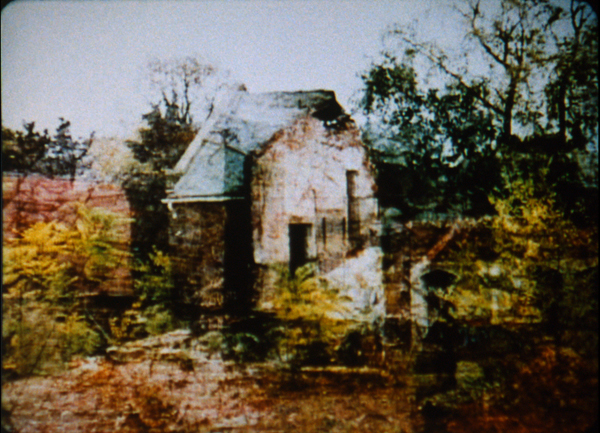 Image: Christ Church – Saint James (Stephen Broomer, 2011). Courtesy of the artist.
Image: Christ Church – Saint James (Stephen Broomer, 2011). Courtesy of the artist.
CE: Can you talk about your interest in religion as a subject matter for your films? Should the abandoned and decaying sacred spaces in Christ Church – Saint James be read as allegory?
SB: I’m interested in Christianity, for its iconography, its rituals, its spaces, its legends, their manifestations in art and literature, but I’m also just interested in ritual and legend across history and faith. I also find that I’m often working with perception and form in the way that faith rituals act on perception: you might see certain qualities of repetition and call-and-response in some of my films, or durational qualities that recall the experience of a mass. A mass demands a kind of collective focus that would invite comparisons to the movie theatre. There are motifs in all three of these films to echo those structures of hymn and mass and prayer. As for allegory, with this work I’m recording these ruins – I make no claims of them as a stand-in for anything greater than what they are.
CE: Is it just me or do you actually make the sign of the cross with your camera in Brébeuf ?
SB: Who would do a thing like that?
CE: I’m not accusing you of sacrilege. Many of your films contain documentation of repeated performed gestures. Watching you shoot this summer, I witnessed you repeat an incredibly violent and exhausting gesture, which consisted of lifting a Bolex camera above your head and throwing it towards the ground while recording at 12 frames per second.
SB: Oh yeah, those gestures are running through my work, from Balinese Rebar (2011) on. I do this in part to create abstraction – I mean, they recall action painting – but I’ve also been working to control it, to have a pretty clear idea of what that gesture captures, what it does to the subject, beyond what it means to perform it. I’ve been working with a lot of variables – frame rates, focal lengths – to create different textures.
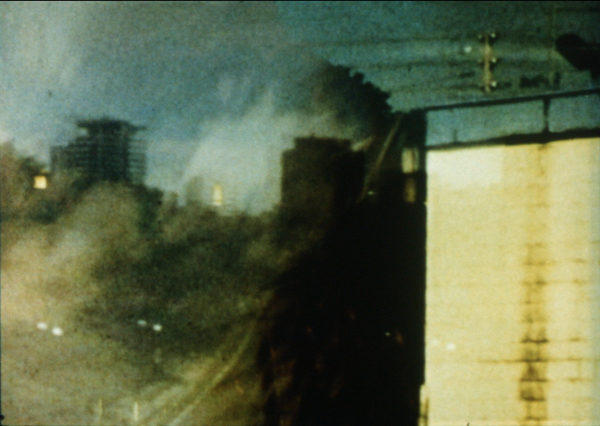
Image: Balinese Rebar (Stephen Broomer, 2011). Courtesy of the artist.
CE: Another recurring theme in your work is the transformation of urban eyesores into colorful, densely layered objects of beauty. In particular, in The Order of Ideas at the Leslie Street Spit (2012), Balinese Rebar and Queen's Quay (2012). The Leslie Street Spit is the ideal image of a post-apocalyptic world full of construction detritus. In fact, the city sign warns visitors that “persons entering these premises do so at their own risk.” Similarly, in Queen's Quay you document the condominiums that pollute Toronto’s Harbourfront neighbourhood.
SB: I see what you’re saying about the Leslie Spit. There are beautiful wildflowers and dense woods and clear beaches that run all along it, as well as buried cement blocks and a lot of consumer debris and rusted-out sheet metal. Balinese Rebar was shot in an industrial corridor in East York, which is where those garages and factories are, or were, and the images of Yonge Street, the spinning motif, that was shot at a bridge that overlooks Yonge Street at Davisville. The materials that make up Balinese Rebar and Queen’s Quay were shot in 2002. The title Balinese Rabar also references the music in that the film. The film is accompanied by gamelan music, although it is actually performed by musicians of Java, not of Bali.
CE: How do you choose musical collaborators?
SB: I worked with the English free-improvisation saxophonist John Butcher for Christ Church – Saint James, and with the American trumpeter Nate Wooley for Spirits in Season (2012). Before approaching John, I was watching the film while listening to his recording “A Short Time to Sing,” from his album The Geometry of Sentiment, and was delighted by the chance pairing of image and sound, and got in touch with him about using it. With Nate, I’ve been listening to his work for a long time and I wanted to approach him about collaborating on something. While watching Spirits in Season, I was listening to a recording of his solo trumpet music, which like the piece in the film, generates from deep, distorted tones, using amplification and feedback, amplified breathing, vocalizing through the horn. I really identify with both Nate’s and John’s processes – in the way they use electronics and feedback, and the part that decay and space and breathing play in their work – in some ways my use of hybrid processes evolved out of my fascination with this aspect of their work. Those strategies in my work come from music. As for my other soundtracks, I pilfer here and there. I like working with music because of the kind of complementary or clashing rhythmic structures that I can find in music.
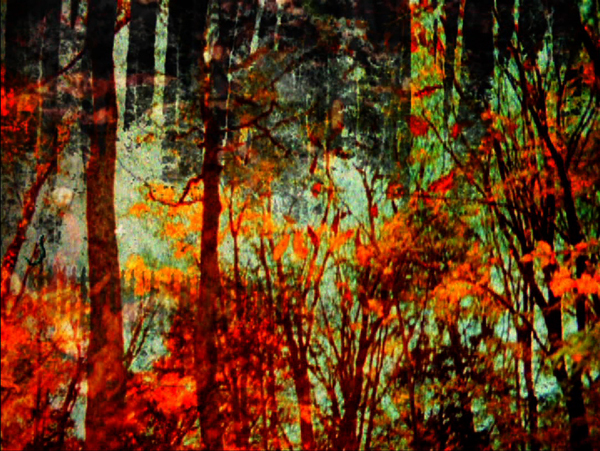
Image: Spirits in Season (Stephen Broomer, 2012). Courtesy of the artist.
CE: Where did you find the pet cemetery used in Spirits in Season?
SB: The setting of Spirits in Season is Lily Dale Assembly, New York, the home of the American spiritualist movement. It’s about 135 years old, and now serves as something of a retirement community for spiritualists and psychics. I knew about it for some time, but I’d never been there. In the spring and summer months they host visitors from all over the world, for services at their temple. Contrary to the title, the film was shot in their off-season, in the fall. The sequence of the pet cemetery, which is near the entrance to the Leolyn Woods, was originally going to be brief – but I was so taken with these memorials that I had to shoot a lot of material. As I went further into the woods, I found the Inspiration Stump, which is a tree stump with steps leading up it, with rows of pews lined up in front of it. Services have been held there since 1898. And people leave little objects on it – for example, when I shot there, there was a child’s rubber bracelet on the stump.
CE: Would it be safe to assume that you take more inspiration from 1960s-era filmmakers than from contemporary ones? Where do you see your work fitting into the current experimental film milieu?
SB: Some of my favorite filmmakers were active in the 60s, but my work comes from the present moment. I don’t think it’s my role to make pronouncements as to where precisely my work fits in the contemporary experimental film milieu. Perhaps somewhere between Stan Brakhage and Carl Brown, based purely on lexicographic ordering. Where do you see your work as fitting into the current experimental film milieu?
CE: I’m pretty sure people see me as a temporary con-artist. Speaking of trickery, your newest film, Pepper’s Ghost is one of the most complex de/re-mystifications of cinema I have ever seen. It’s as if the more that is revealed to the audience, the more mystified it becomes! How was it made?
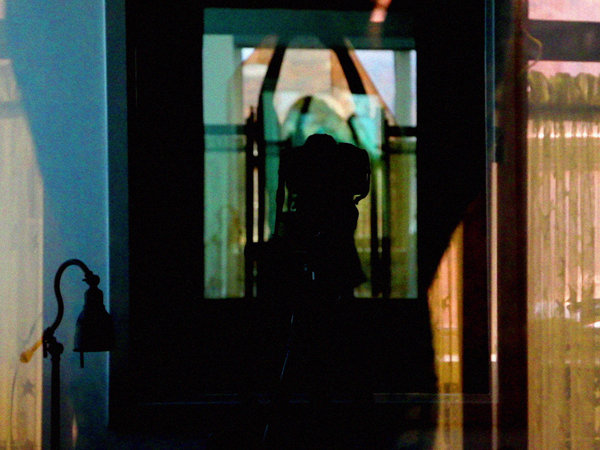
Image: Pepper's Ghost (Stephen Broomer, 2013). Courtesy of the artist.
SB: Pepper’s Ghost began with this interesting space – it’s my office and an adjoining office, which are former psychological observation rooms, so there’s a two-way mirror between them. I realized that I could create simple optical illusions by playing with ceiling lights, gel filters, curtains, and that became a perfect real-world analogue for the illusions that I was creating in my films through computer manipulation. I enlisted my friends Cameron Moneo and Eva Kolcze to join me in shaping the illusion. It’s my first substantial piece made in video, using a DSLR, and I decided it would just be stationary, and that our role in the piece would be to assist the camera in achieving these illusions by performing around it. Our actions would often transform the image in unpredictable ways.
CE: Although you often work across media, why is finishing on film important for you?
SB: For some pieces, finishing on film is important for the work itself. I still have a lot of faith in the darkened theatre, the flicker of the projected image, but that aside, new qualities emerge from out of these pieces when they’re rephotographed. Some would talk about generation losses in the act of rephotography, but you also gain something. As for why it is important to me, I see it as a final act of “finishing” a work. The negative and the optical soundtrack are made, and that is my gesture of commitment to the work as it is. I know then – no more revisions!
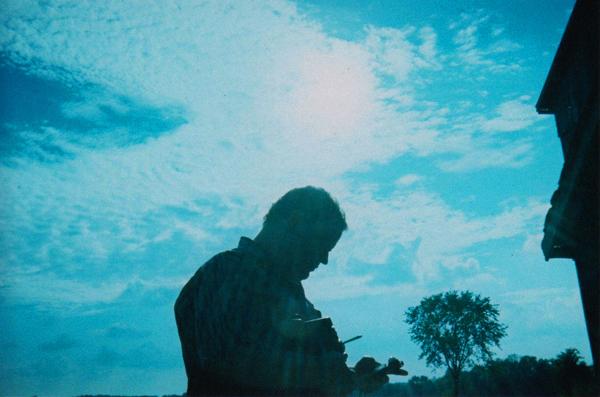
Image: Stephen Broomer shooting 16mm film. Photo by Clint Enns.
Stephen Broomer – Filmography
Manor Road, 2010, 16mm, silent, 3:25
Christ Church – Saint James, 2011, 16mm, sound, 6:43
Balinese Rebar, 2011, 16mm, sound, 3:32
Memory Worked by Mirrors, 2011, 16mm, silent, 2:20
Brébeuf, 2012, 16mm, sound, 10:32
The Order of Ideas at the Leslie Street Spit, 2012, 16mm, sound, 3:32
Snakegrass, 2012, 16mm, sound, 1:08
Queen’s Quay, 2012, 16mm, sound, 1:12
Spirits in Season, 2012, 16mm, sound, 12:17
Apis in Memphis, 2013, HD, sound, 1:11
Blue Guitar, 2013, UltraPan8, silent, 5:10
Ravine, 2013, UltraPan8, sound, 4:31
Championship, 2013, 16mm, sound, 21:30
Pepper’s Ghost, 2013, HD, sound, 18:31
Conservatory, 2013, 16mm, sound, 3:32
Published September 4, 2013
ABOUT THE AUTHOR
Clint Enns is a Toronto-based video artist and filmmaker. Hiw work has screened nationally and internationally at festivals, alternative spaces, and microcinemas. He has a Master's degree in mathematics from the University of Manitoba as well as a Master's degree in cinema and media from York University. His writing has appeared in Millennium Film Journal, INCITE, and Spectacular Optical.
